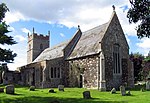Wissington, Norfolk
Biofuel power stations in EnglandEconomy of NorfolkFormer populated places in NorfolkIndustrial railways in EnglandManufacturing plants in England ... and 4 more
Power stations in the East of EnglandSugar industry in the United KingdomSugar refineriesUse British English from January 2017
Wissington in Norfolk is the site of British Sugar's largest sugar factory in the UK; it is also the largest in Europe. There has been a sugar factory there since 1925; however none of the rest of the village remains, other than the name. British Sugar has opened the UK's first bioethanol plant here.
Excerpt from the Wikipedia article Wissington, Norfolk (License: CC BY-SA 3.0, Authors).Wissington, Norfolk
College Road, King's Lynn and West Norfolk
Geographical coordinates (GPS) Address Nearby Places Show on map
Geographical coordinates (GPS)
| Latitude | Longitude |
|---|---|
| N 52.550251 ° | E 0.449442 ° |
Address
College Road
PE33 9US King's Lynn and West Norfolk
England, United Kingdom
Open on Google Maps









